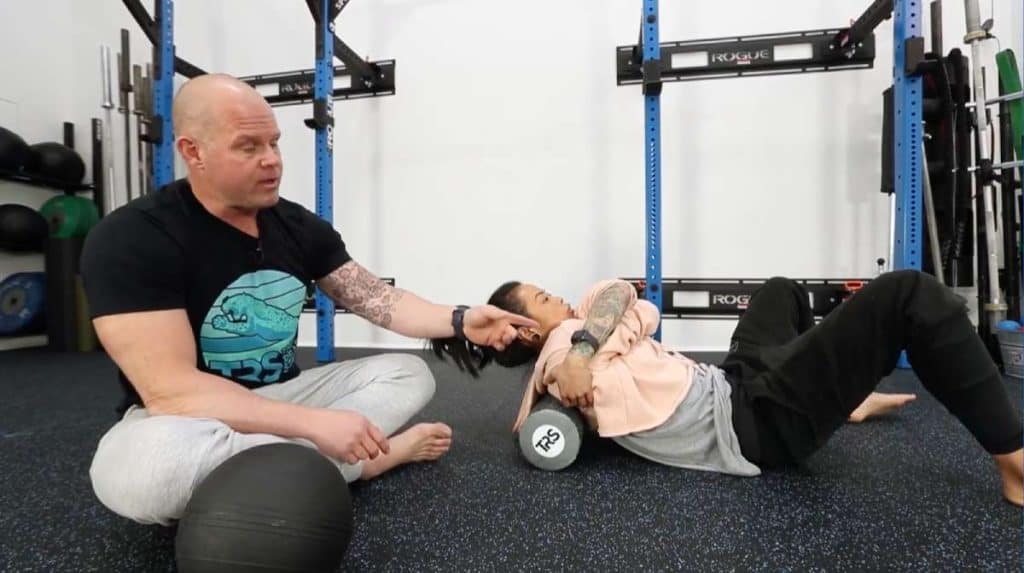Upper Back Pain Relief: Effective Techniques & Tips For A Pain Free Life
When it comes to back pain, most tools out there are focused on the lower back or lumbar spine. With good reason.
Lumbar injury and pain is as debilitating as it is common. It has, potential nerve impingements and implications for your legs and lower body.
The upper back, or thoracic spine (T-spine for short) gets less attention. And that’s a shame.
Not only do we see that issues with the T-spine are anything but rare, they’re also misdiagnosed for other problems all the time.
Shoulders hurt? Neck pain? Slouching? Even tricep, elbow, and wrist pain all tie back to the functional capacity of your T-spine.
Not that pain from the upper back has to be in any of these places. If you’re reading this, my guess is your back hurts.
You’re in the right place because we’ll discuss how to relieve upper back pain in this article. While dedicated programs may be more scarce elsewhere, this is one of our favorite topics at The Ready State. We believe improving t-spine mechanics means improving everything else.
What Is The Thoracic Spine? (and How Does Pain Happen?)
The truth is, your thoracic spine is a beautiful network of incredible tissues that interweaves to create and stabilize your whole upper body. When we think in terms of pain in the thoracic spine, we’re looking at your”
- Neck;
- traps;
- lats;
- scapula
- obliques;
- and chest and how all these tissues map across each other.
Of these, many are ignored when it comes to regular mobility work and proper warmup. They aren’t appreciated for the role they play in total body movement and health.
For example, your lats are like the hamstrings of your spine. But how often do you think about really warming them up or getting in there with a ball or roller?
When was the last time you poked around in the meat in the back of your shoulder? Or gave attention to the seams where these tissue systems connect?
You can often relieve thoracic pain without ever having to roll on top of the painful tissue itself. Everything here is so interconnected that you can create relief working with your less-sensitive tissues, before approaching the point of pain or injury.
When upper back pain strikes, here’s what to do:
- Desensitize
- Restore
- Prevent
These are the three stages of all our pain protocols, and we’ll be using them here to get you relief for your back pain. It doesn’t matter if the pain originates from the middle of your scapula, under your shoulder blades, or high in your neck,
How to Help Upper Back Pain in Three Steps
First, we want to desensitize your tissues and get you some relief. Back Pain in particular can be debilitating, affecting everything from work to sleep.
Next, we aim to restore functional positions and patterns. Your pain happened for a reason. While that reason might have been an acute incident, more often you’ve developed dysfunctional movement patterns or positions that helped break the camel’s back. It wasn’t the final straw. It was the sum of all the straws that piled on before it.
Finally, we want to prevent pain from returning. This means adequate prep for the tissues that comprise your upper back, and tools to build resilience.
Desensitize (Quick Relief For Upper Back Pain)
When your upper back goes down for the count, your whole life can seem to go with it. The same interconnectedness that makes relieving upper back pain so multifaceted also means pain can radiate and restrict far beyond the area of injury.
Before we start restoring positions of health, we need to get some water on the flames.
Normally we use tools like Gua Sha, percussion devices, or voodoo floss for desensitization and reperfusion. But many of the tissues of the back are, well, on your back.
You can’t wrap it, and reaching around to use a hyperice gun or gua sha isn’t ideal. You could have a friend help, but you won’t be able to do it on the regular. So today I want to highlight a tool you can use all by yourself that is often overlooked when it comes to at-home remedies:
Cupping
Cupping has been popular in clinics and social media posts since it reached global fame after Michael Phelps walked out covered in “cupperoni” spots at the Beijing Olympics. Thing is, this tool is affordable and available to the lay-person working on their mobility at home.
Here’s a great primer on cupping with my friend Dr. Chris Daprato of Myofascial Decompression:
For your upper back, try cupping your traps, scapula, lats, or the back of your shoulders. Then simply go through some basic range of motion drills like yoga’s cat-cow stretch, or simply leave the cups on for 2-5 minutes and then remove. Either method will decompress tissues and create decongestion and reperfusion effects that can lower pain.
For some spots you may still need a friend to attach them, but once they’re on you’re good to go. You can also slide cups across tissues, as shown in the video, to get a scraping “gua sha” effect.
Equipment needed: Basic cupping kit or Full cupping kit
Perform 2-5 minutes per day per side of range of motion drills with cups on. You can also incorporate deep breaths as you go.
Restore Trunk Rotation
Next we want to look at restoring function to the trunk, and this often looks like rotation. If your lats get too tight, you spend too much time hunched over or too little time rotating. What we see is a remarkable restriction of thoracic tissues.
The lats are like the hamstrings of the upper body. Any idea what stiff hamstrings feel like? Clue: Not fun. So when we talk about restoring thoracic function, we’re naturally talking about restoring rotation by looking at the lateral seam.
At a minimum, spend ten minutes a day scrubbing your lats. It makes for a great starting position. But if you have time, I highly recommend the following 30-minute daily maintenance routine for a total trunk makeover:
Queen Bess
The other area where trunk function becomes impaired is simply flexion and extension. Using a textured roller, you can restore this with 5-10 minutes of basic mobilization of the t-spine. This can reduce pain over time. But if it aggravates your existing pain, you need to stop.
Foam Roller T Spine Scrub
Equipment needed: textured foam roller.
Perform 5-10 minutes of lat mobilization per side or of t-spine scrubbing per day, or do the Queen Bess daily maintenance routine.
Prevent Upper Back Pain From Returning
I want to assure you pain is a temporary problem. We’re not only here to talk about how to fix upper back pain. I assure you once it’s gone we can keep it from coming back. This is something that over the counter pain medications can’t guarantee.
The best medicine is preventative after all.
One of the common causes of upper back pain is stagnation. Put another way, not moving enough.
Stagnation contributes to all kinds of pain through detrimental effects on our health across the board. NASA has documented how lack of movement can accelerate aging via increased blood pressure, loss of functional muscle mass, and all manner of other factors.
The insult to literal injury is that most of us are stagnant and stooped over in the very rounded positions that invite pain to make its home between our shoulder blades.
The best prevention therefore is a restructuring of your daily movement routine to promote, well, movement. Here are the 3 key components.
- Walk 8000 steps a day: Many of the issues from stagnation are simply due to lack of movement. Aiming for 8000 steps a day minimum should be your goal. This can also help sleep by accruing adequate amounts of non-exercise fatigue. If there were only one exercise for longevity to bet your hat on, he who walks often walks longest.
- Sit on the floor more: The first movement vital sign in our newest book: Built To Move, is about how well you can sit down and get up from the floor for a reason. Research has found that your score on a test of your ability to get up from the ground without using your hands directly correlates with how long you’ll live.
Spending more time on the floor also means more variety of postures to stay comfortable.
You’ll need a laptop stand (the Varidesk is our preference). This will allow you to easily work on the floor or turn your desk into a standing workstation. - Modify your workstation: Poor posture is a big contributor to upper and middle back pain. Use the Varidesk stand or a full-sized desk to work on the floor or turn your desk into a standing desk.
If you want to go further, look into a treadmill workstation. I also suggest filling your work area with tools for exercise or mobility. Examples are foam rollers and lacrosse balls on hand, and a peanut on your desk for forearm mobs. You can also get a percussion gun and install a pull-up bar in the door.
NASA research shows that simply changing posture every thirty minutes is enough to prevent the effects of stagnation. One of our favorite ways to do this is to combine with the Grease-The-Groove training method developed by Pavel Tsatsouline. Basically, just do 5 reps of an exercise every half hour, or do 5 minutes of mobilizing.
Bonus: Sleep 8 hours while healing which may mean being in bed for 10 hours. Sleep is your body’s numero uno recovery process.
When in pain, prioritize sleeping 8 hours a night which may mean being in bed for 10.
You can prevent future injury by following the same guidelines during times of high stress or hard training. Sleep is for the weak? Nay. Sleep makes you strong.
Manage Upper Back Pain: Other Ways To Relieve It
Aside from the stretching exercises and posture correction tips we’ve outlined above, try:
- Managing symptoms & pain using heating pads and we recommend against the use of ice.
- Get a professional massage or physical therapy. This will relieve tight muscles and improve your spine’s health.
- Practice deep breathing exercises to relieve neck and back tension associated with stress. Add yoga or meditation to your routine for better posture and flexibility.
- Stretch and move around during work breaks. Doing so can prevent prolonged periods of sitting that can cause stress-related pain.
- Stay physically active, eat healthily, and get enough sleep to maintain stress resilience.
How To Get Rid of Upper Back Pain
Back pain can be debilitating. Upper back pain often receives less press than lower back pain. Despite that, it can be just as debilitating if not more so.
Some of the biggest movers of your upper body are part of the thoracic, or upper, back. Your lats, rear deltoids, scapula and even parts of your chest, triceps, neck and obliques participate in this intricate web of spinal engines.
If you strain, pull, knot, or tear anything in this region, the effects will ripple across the whole network like a net pulled tight.
Thankfully, this same ability to immobilize you is your route to freedom. You can effectively desensitize pain and restore function by going after the less-painful tissues where you can tolerate it and still see resolution in the long run. Use the exercises for upper back pain we’ve outlined above.
After that, it’s just about preventing the problem from coming back. This usually means taking a good look at your daily movement habits and your workstation, and adapting accordingly using the tools mentioned in this article.
If you have any questions or concerns, or just want to tell us how our information on upper back pain treatment helped you, engage with us in the comments below.





















TRS Virtual Mobility Coach
Guided mobilization videos customized for your body and lifestyle.
FREE 7-Day Trial